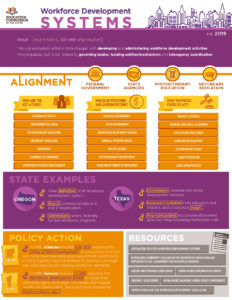As any good meeting planner will tell you, one needs to ensure the right individuals attend. Those who can provide insight and guidance to any topic you discuss are essential members of the group. In some ways, the existing composition of workforce development boards or councils across the states requires those with essential expertise to be at the table. How can states ensure the needs of education and the workforce are met, if key actors are not at the table?
Per section 101(b) of the Workforce Innovation and Opportunity Act (WIOA), each governor must establish a state workforce development board to carry out the functions in section (d) of the law. The law sets forth specific requirements related to the composition of the board; however, some states go beyond those to ensure the right composition relative to their own workforce needs.
In 2018, we conducted a qualitative case study to learn about what states found to be the most useful in creating a successful workforce development system. Coordination and collaboration rose to the top as key components in each of the four states interviewed. States highlighted the need to create strong relationships across agencies and departments to ensure clear pathways from education to the workforce. Workforce development boards provide a venue to convene key stakeholders working across the state to align skills and credentials with employer needs. State workforce boards specifically emphasize the importance of including representatives from education, state-level agencies, employers and labor at the table.
Every state and the District of Columbia include state education representatives on their workforce boards. Georgia houses its board within the Technical College System of Georgia, clearly aligning education outputs with state workforce needs. Fifteen states require, through statute or executive order, the inclusion of postsecondary education representation on the board. With the continued rhetoric that the pool of future workers lack the skills for the jobs of the future, the importance of postsecondary education in workforce development planning proves to be imperative.
Six states — Alaska, Delaware, Idaho, Michigan, North Carolina, and Virginia — require the inclusion of health and human services departments or agencies. Including HHS provides the perspectives of individuals who need connections to certain state services and may run into roadblocks in the pathways to employment. Roadblocks may include access to child care, education funding and social services, and housing.
An integral partner in workforce development systems and boards are chambers of commerce. Chambers cultivate direct partnerships between economic development needs of the state and regions with current and future employers. Their awareness of the skills needed for future jobs allows chambers to play a unique role in connecting education and employers. Many states include chambers as board members and rely on their knowledge in state and regional workforce planning.
The composition and diverse perspectives of those who make up workforce development boards allows them to explore and carry out their responsibilities as they align with their mission and charge. WIOA section 101, subsection (d) also outlines the main functions of the board; however, like in board compositions, some states go beyond federal requirements. Duties vary, including the development of a state plan, continuous improvement of the workforce development system, dissemination of information on best practices, development of strategies for aligning technology and data systems, and development of policies promoting statewide objectives for the workforce development system.
Stay tuned for more information in the next post in the series, detailing the duties of workforce boards and how states go beyond based on their state-specific missions.
















